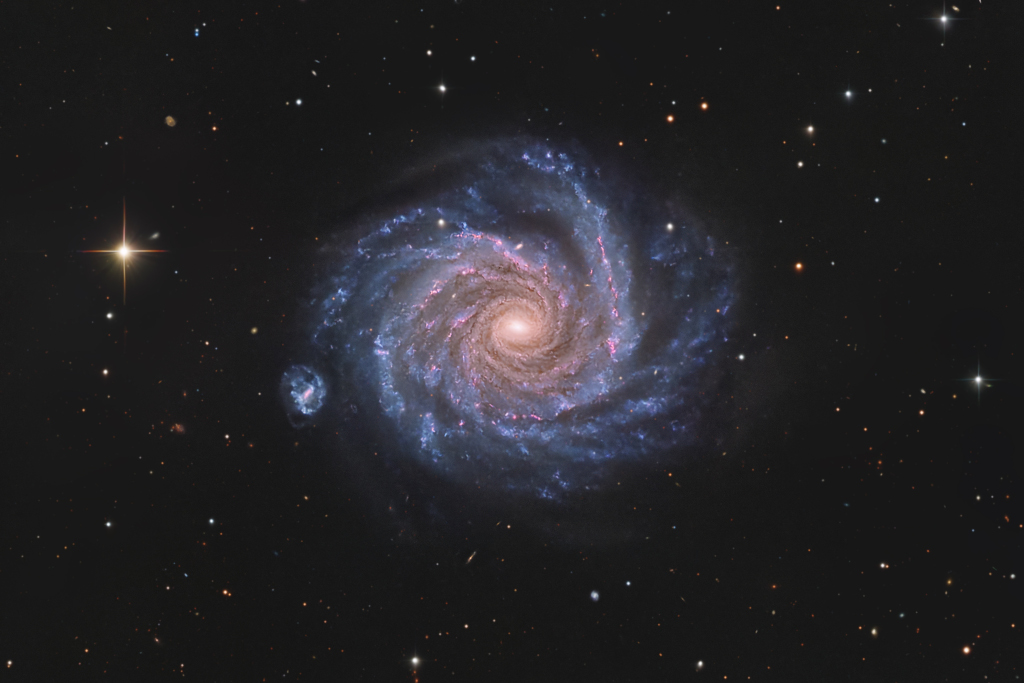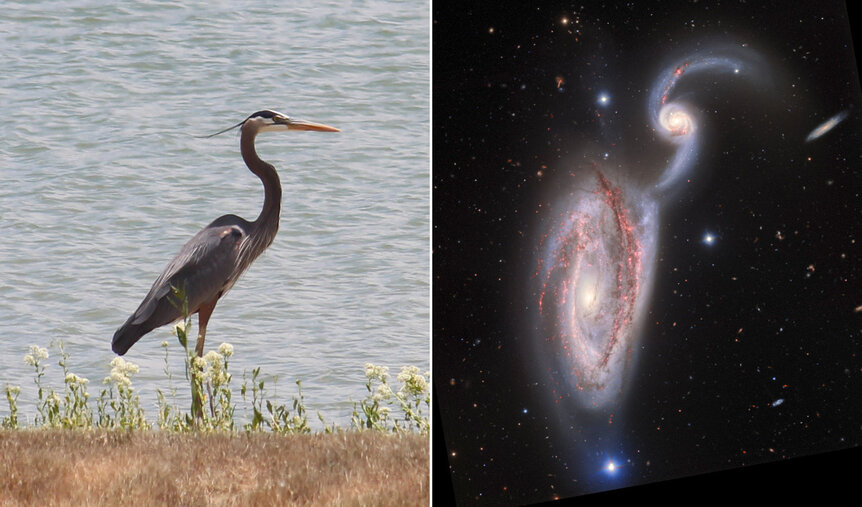Yes, I like it! ![Very Happy :D]()
What I particularly like about Neil Corke's portrait of NGC 1232 is that he shows us the pink emission nebulas in the arms. These are invisible in the ESO APOD. I also like the inclusion of a foreground star, HD 19764 of spectral class K1 III. I find its color perfect for its spectral class. Also note how, on the "top arm", the top end of it continues to the left, but without the young blue stars.
It is actually quite common that galaxies have features of old stars that reach beyond the bright blue regions of star formation. Note in this brilliant photo by R. Jay GaBany how starbursting NGC 4449 is enveloped in a halo of old stars (and there is an elongated structure of old stars near it):
The most mysterious aspect of NGC 1232 is its apparent companion galaxy, NGC 1232A, seen immediately to the lower left of NGC 1232 proper. It's hard to accept that NGC 1232A is a large background galaxy, located some 300 million light-years away, compared with 47 million light-years away for NGC 1232, because the two galaxies look so similar in shape and stellar types and only different in size. But when you think of it, it makes sense that NGC 1232A is a background object. Let's look at some galaxies that are either interacting or located at very different distances from one another:
So the Heron galaxy and M101/NGC 5474 are examples of large galaxies interacting with a much smaller galaxy. The smaller galaxies are very visibly affected by the interaction.
NGC 7320 and the background ring galaxy inside Hoag's Object are examples of foreground or background galaxies that are not interacting.
If we look at NGC 1232A again, we see no obvious signs of interaction. Unfortunately, there exist no really sharp pictures of it.
NGC 1232A does look somewhat disturbed, but some galaxies do, for no immediately obvious reason. Consider NGC 1313, which lives in splendid isolation but is still acting up.
Also let's compare NGC 1232 itself with M101. Remember that M101 is indeed interacting with NGC 5474.
In my opinion, M101 looks considerably more disturbed than NGC 1232. If NGC 1232A had indeed been a satellite of NGC 1232, the shape of the larger galaxy would probably have been disturbed. So I think we can agree that NGC 1232A is indeed a background object!
Ann
What I particularly like about Neil Corke's portrait of NGC 1232 is that he shows us the pink emission nebulas in the arms. These are invisible in the ESO APOD. I also like the inclusion of a foreground star, HD 19764 of spectral class K1 III. I find its color perfect for its spectral class. Also note how, on the "top arm", the top end of it continues to the left, but without the young blue stars.
It is actually quite common that galaxies have features of old stars that reach beyond the bright blue regions of star formation. Note in this brilliant photo by R. Jay GaBany how starbursting NGC 4449 is enveloped in a halo of old stars (and there is an elongated structure of old stars near it):
NGC 4449. Credit: R. Jay GaBany.
The most mysterious aspect of NGC 1232 is its apparent companion galaxy, NGC 1232A, seen immediately to the lower left of NGC 1232 proper. It's hard to accept that NGC 1232A is a large background galaxy, located some 300 million light-years away, compared with 47 million light-years away for NGC 1232, because the two galaxies look so similar in shape and stellar types and only different in size. But when you think of it, it makes sense that NGC 1232A is a background object. Let's look at some galaxies that are either interacting or located at very different distances from one another:
So the Heron galaxy and M101/NGC 5474 are examples of large galaxies interacting with a much smaller galaxy. The smaller galaxies are very visibly affected by the interaction.
NGC 7320 and the background ring galaxy inside Hoag's Object are examples of foreground or background galaxies that are not interacting.
If we look at NGC 1232A again, we see no obvious signs of interaction. Unfortunately, there exist no really sharp pictures of it.
NGC 1232A does look somewhat disturbed, but some galaxies do, for no immediately obvious reason. Consider NGC 1313, which lives in splendid isolation but is still acting up.
Also let's compare NGC 1232 itself with M101. Remember that M101 is indeed interacting with NGC 5474.
In my opinion, M101 looks considerably more disturbed than NGC 1232. If NGC 1232A had indeed been a satellite of NGC 1232, the shape of the larger galaxy would probably have been disturbed. So I think we can agree that NGC 1232A is indeed a background object!
Ann
Statistics: Posted by Ann — Thu Apr 18, 2024 7:07 am — Replies 1 — Views 121







